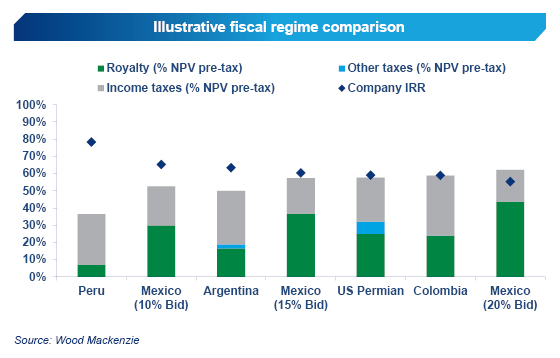Mexico opens bidding for 26 on-shore conventional fields
Mexico not yet including high-potential conventional fields as part of reforms
Mexico is hoping small national exploration and production companies will benefit from the next phase of Round One of reforming its oil and gas industry.
 Overall, this round could be very attractive for smaller players, but it will not lift Mexico’s oil production significantly,” said Pablo Medina, research analyst at industry research group Wood Mackenzie. “If the objective is to allow Mexican companies to be part of the new energy landscape by offering small fields and flexible pre-qualification criteria, then it could be a success.”
Overall, this round could be very attractive for smaller players, but it will not lift Mexico’s oil production significantly,” said Pablo Medina, research analyst at industry research group Wood Mackenzie. “If the objective is to allow Mexican companies to be part of the new energy landscape by offering small fields and flexible pre-qualification criteria, then it could be a success.”
According to Wood Mackenzie, this round adds a “progressive adjustment mechanism” that introduces a production metric that only triggers at volumes greater than the expected potential of the fields on offer, indicating that it might be used for larger fields in the future. Wood Mackenzie believes the fiscal regime is competitive. Key opportunities for companies looking for sizable onshore fields will be the migrated service contracts and the Pemex joint ventures.
The next phase of Round One offers 26 on-shore conventional fields located in the Burgos, Tampico-Misantla, and Salinas-Sureste Basins. The move is expected to bring in about $620 million in investment in the first five years, Energy Minister Pedro Joaquin Coldwell said last week.
The qualification criteria are very different from the shallow-water development round. This enables new Mexican E&P companies to participate in the round.
The National Hydrocarbons Commission oil and gas regulator approved the auction for the land-based areas in five states in southern and northern Mexico, which together could yield 35,000 barrels of oil and 225 million cubic feet of gas per day.
This is the third of five sets of areas Mexico plans to auction in a first round. The previous two auctions were for areas in shallow water.
This first round of auctions has put in motion the historic reform of the energy sector passed last year. It signalled the end of a period that began with the nationalization of the oil industry in 1938.
“Unlike the previous two rounds, this round will use a license contract with bidding variables including additional royalty and work commitment,” said Medina. “The regime has the potential to be very attractive, although it will ultimately depend on the minimum acceptable bid level that will be announced at a future date.”
Edgar Rangel, a member of the National Hydrocarbons Commission, told Reuters on May 12 that the areas would have average production costs of between $10 and $20 per barrel, below previously announced shallow water contracts. Competing companies must demonstrate financial capacity of between $5 million and $200 million, as well as operational experience and expertise. License contracts will be granted for 25 years, with extensions of up to two additional periods of five years each.
“If the objective is to attract a diversity of larger international companies with expertise in mature fields, then the round could fall short of expectations due to the small number of high-potential fields on offer,” said Medina, noting that the competitive fiscal regime offers smaller companies a good opportunity to develop their expertise in Mexico while being able to obtain attractive returns.
The lack of big opportunities suggest that Pemex may not have relinquished a large number of high-potential fields in Round Zero, Medina said in a Wood Mackenzie press release. Either Pemex kept most of the high-potential onshore opportunities or the government has decided to license those larger onshore opportunities in later rounds with the expectation of future higher oil prices.
“It’s important to keep in mind that Pemex could be forced to relinquish additional assets as a result of its budget cuts,” said Medina.







